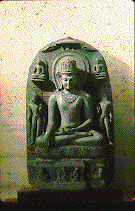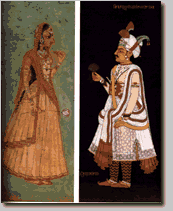Classical Indian Paintings
(Cave Paintings, Murals, Manuscripts, Paintings, and Books)

(Cave Paintings, Murals, Manuscripts, Paintings, and Books)

Art and religion were intertwined in ancient India. Both a doorway to the gods, art and religion were one in the same experience. By looking at the early Indian paintings of Buddhist murals and cave paintings of noble figures, we can see that from the beginning, Indians felt a spiritual connection with art. It is with the Gupta period that classical Indian art raised itself to being powerful, religious and calming all at once. It depicted Buddhas, sleeping women, and love scenes.
Further information from the University of Pennslyvania, click here
The Pala school of painting lasted from 750-1200. Surviving manuscripts once again display scenes from the life of Buddha. Also produced were religious manuscripts, (Kalpa Sutras) that reveal conduct, customs, and dress of the culture. Unlike the Gupta period, all illustrations were done on palm-leaf manuscripts. Paper was not introduced in India until the thirteenth century.
Illustrations in books and small scale albums were an important art form in India during the sixteenth through the nineteenth centuries. Indians were greatly influenced by books from Iran, Turkey, and Central Asia. The Mungal court ruled over much of Northern India, and the Rajput kings ruled over Northerwestern India during this time period.
Art was greatly supported by the Mungal court because they found it as a way to historically chronicled kings and events. The paintings were dramatically realistic in detail, emphasizing a specific individual, moment or event.

Raiput paintings also held courtly themes and subjects. By the late fifthteenth century illustrated books with Hindu themes and stories were produced in Northwestern India. The Bhagarata Purana, a book depicting the accomplishments of the god, Krishana, was one of the most popular books from this period.
For more information from the exhibition: Alamkara: 5000 Years of Indian Art
Another book, the Ta'rkh-i-Alfi (History of a Thousand Years) was sponsored by the Mungal court. This very large book, contained the Islamic history starting from the birth of Muhammad.
By the end of the late 1800's traditional Indian art began to fade. Indian art was being influenced by Western styles. Then archeological studies in India during the middle of the 19th century began to influence Indian artists to return to older Indian styles.

References: Basil Gray, The Arts of India, Cornell University Press, Ithaca, NY, 1981
Text by Regina Vista
Design by CSL
(Basic Design, City College of San Francisco)